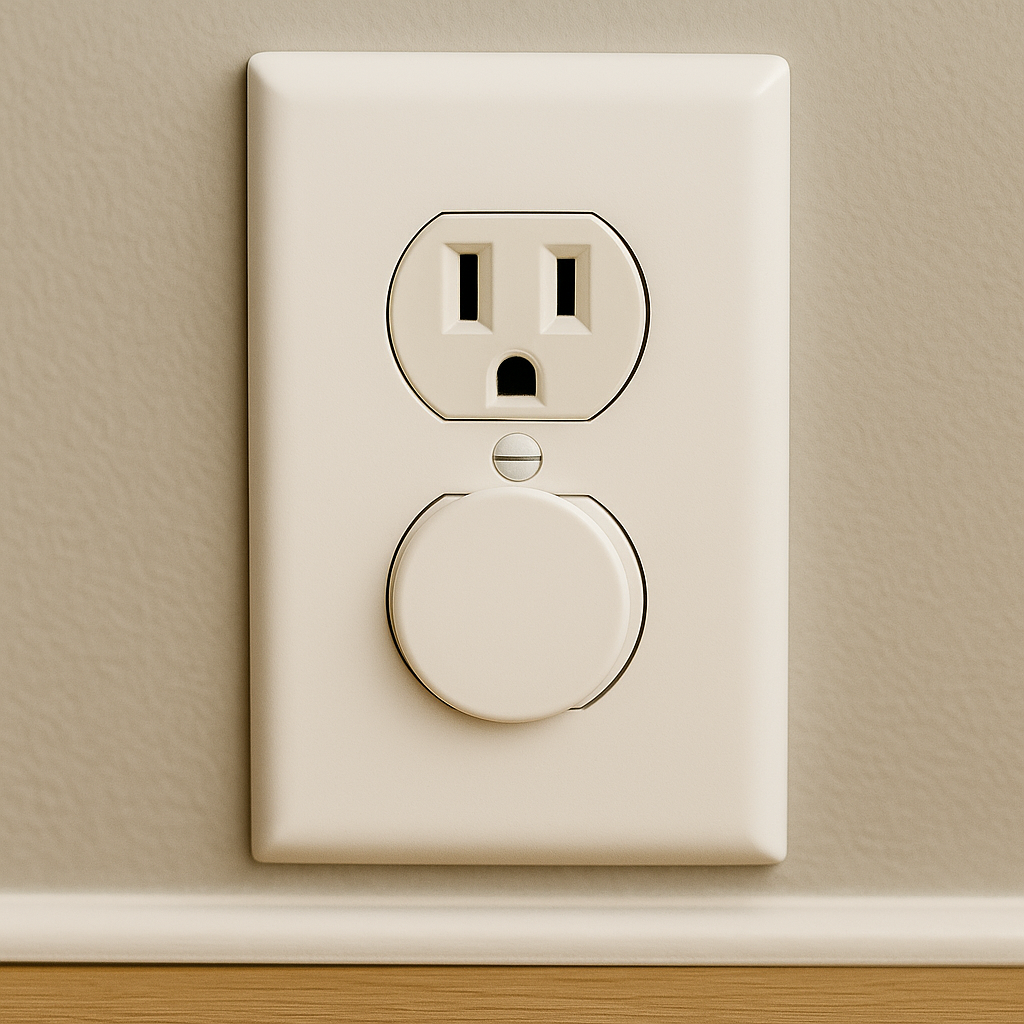10 Warning Signs Your Home Needs Electrical Work
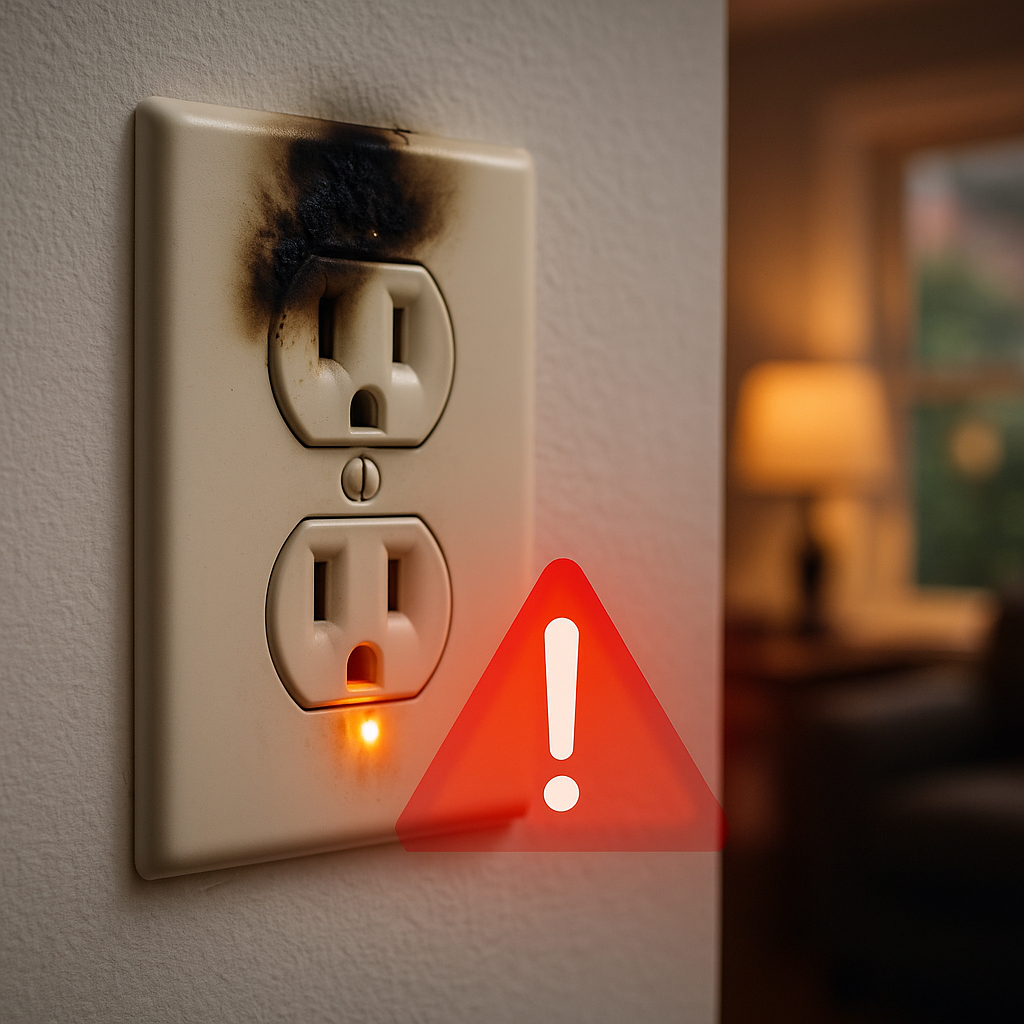
Introduction
Your home’s electrical system is the backbone of modern living, powering everything from your lighting and appliances to heating and cooling systems. Yet, unlike a leaky faucet or a squeaky door, electrical issues often lurk unnoticed until they become emergencies—resulting in unexpected outages, costly repairs, or even dangerous house fires. According to the National Fire Protection Association, electrical failures or malfunctions were the second leading cause of U.S. home fires between 2015 and 2019, accounting for over 43,000 incidents annually. Spotting early warning signs not only protects your loved ones and property but also extends the lifespan of your devices and can reduce your energy bills. In this article, we’ll dive into the 10 most critical indicators—from frequent breaker trips to unexplained energy spikes—that signal it’s time to call a licensed electrician. Read on to learn how simple observations today can prevent major headaches tomorrow.
Table of Contents
1. Frequent Circuit Breaker Trips
2. Flickering or Dimming Lights
3. Burning Smell or Scorch Marks
4. Buzzing or Humming Sounds
5. Warm or Hot Outlets & Switches
6. Sparks When Plugging In or Unplugging
7. Outdated Wiring Systems
8. Electrical Shocks or Tingling
9. Unexplained High Energy Bills
10. Aging or Faulty Electrical Panel
11. Conclusion
12. FAQs
1. Frequent Circuit Breaker Trips
When a breaker trips repeatedly—even under light loads—it’s a sign that a circuit is overloaded or there’s a short or ground fault drawing excessive current. Constantly resetting the breaker stresses wiring and insulation, increasing the risk of arcing or fire.
A licensed electrician can perform a load analysis to identify which devices are overtaxing your circuits, redistribute outlets or add new branch circuits, and inspect connections for damage or moisture. If your panel is undersized for today’s appliances, they may recommend a panel upgrade or sub-panel installation to ensure safe, reliable power.
See
Why Circuit Breaker trips
See
How and Why do Breaker Trips
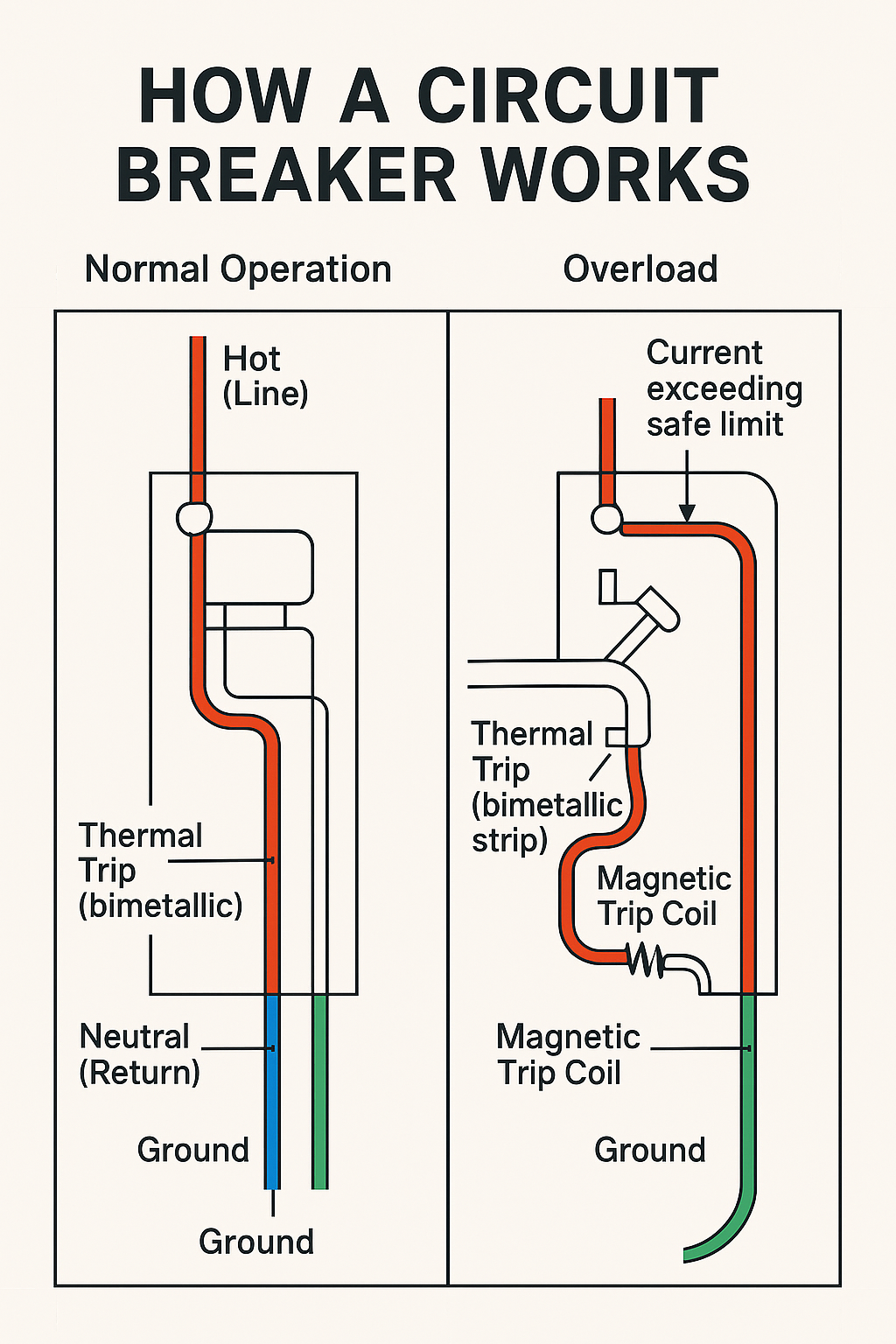
2. Flickering or Dimming Lights
Lights that flicker when large appliances kick on—or that dim unpredictably even when you’re not adding new loads—are classic signs of voltage fluctuations in your home’s wiring. These fluctuations can stem from overloaded circuits where the inrush current of motors (like refrigerators or air conditioners) momentarily drags down voltage, from loose or corroded connections at outlets and junction boxes, or even from issues on the utility side such as an aging transformer. Over time, repeated flickering stresses filament and LED bulbs alike, reducing their lifespan, while the resulting voltage spikes and drops can degrade sensitive electronics, causing data corruption or premature component failure.
To pinpoint and resolve the problem, a licensed electrician will start by measuring voltage under load at various outlets and in your main panel to identify significant drops. They’ll inspect and tighten any loose terminals, replace worn receptacles or switches, and, if needed, reconfigure or rewire circuits to balance loads more evenly. In cases where the existing branch circuits are undersized for modern appliance demands, the electrician may recommend adding dedicated circuits or upgrading service conductors. For added protection, they can also install surge arresters or voltage regulators to safeguard your devices against future fluctuations.
What's the cause of my lights flickering, when they're on multiple breakers
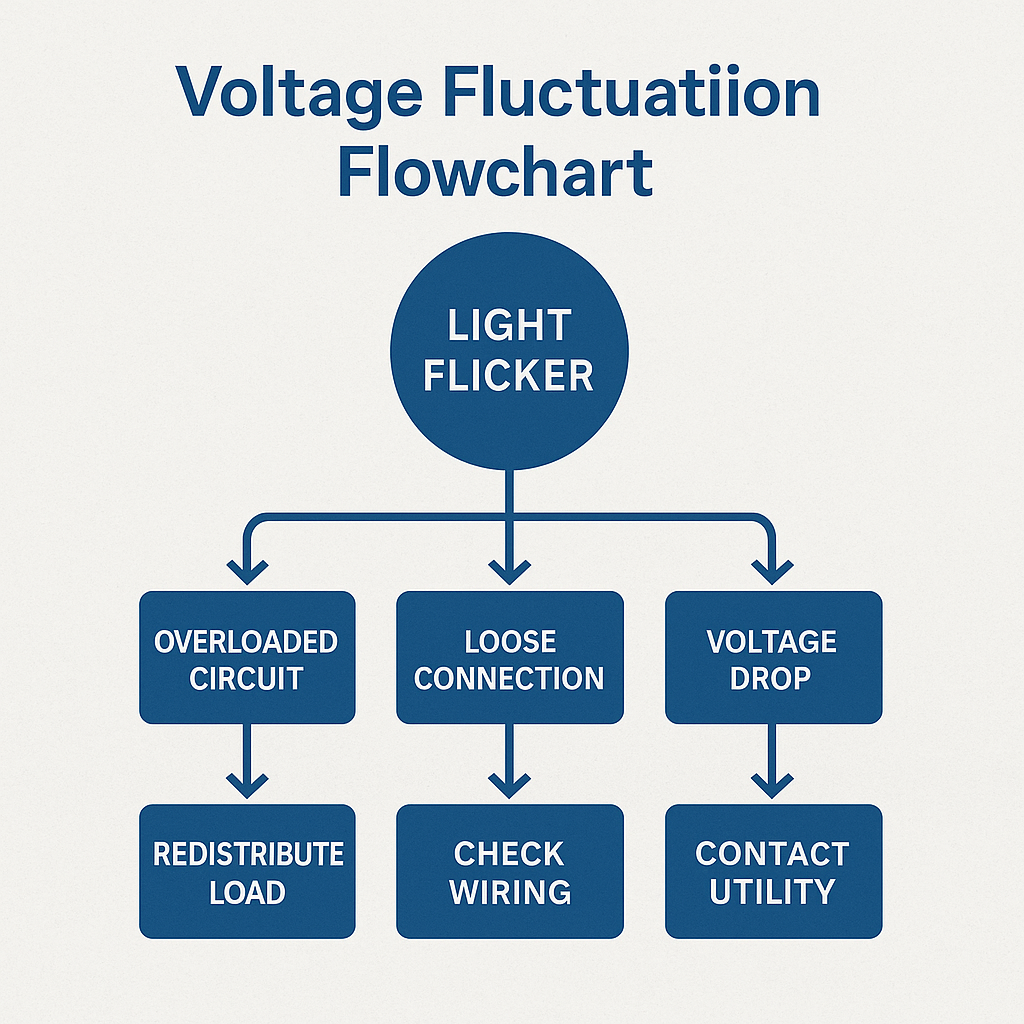
3. Burning Smell or Scorch Marks
A persistent burning plastic or rubber smell—often described as “hot wires” or “melting insulation”—combined with dark scorch marks around outlets, switches, or your main panel is a red-alert indication of arcing or overheating within your home’s wiring. Arcing occurs when an electrical current jumps across a gap in a damaged or loose connection, generating intense heat that degrades insulation and metal components. Overheating can also result from overloaded circuits where wiring gauge is insufficient for the current load. Both scenarios dramatically increase the risk of electrical fires, which can ignite surrounding materials in seconds.
If you detect these warning signs, immediately cut power to the affected circuit at your breaker box and avoid using nearby outlets or switches. Contact a licensed electrician right away: they will conduct a thermal scan to pinpoint hot spots, inspect and tighten or replace damaged connections, and assess whether your wiring and breaker sizing meet current electrical codes. In many cases, older or undersized wiring must be replaced or rerouted, and faulty breakers upgraded, to eliminate fire hazards and restore safe, reliable power to your home.
4. Buzzing or Humming Sounds
Buzzing or humming noises from outlets, switches, or your breaker panel often indicate that electrical current isn’t flowing smoothly through a connection. Loose wire terminals, worn contacts in switches, or a partially tripped breaker can create a small gap where current arcs or vibrates, producing that characteristic sound. Over time, the vibration and heat generated by these imperfect connections degrade insulation and metal parts, increasing the risk of short circuits or fire.
A licensed electrician will use a combination of visual inspection, torque testing on terminal screws, and non-contact voltage detectors to pinpoint the offending component. They’ll tighten or replace loose connections, swap out worn switches or breakers, and verify that all terminations meet manufacturer torque specifications. If the buzzing stems from an overloaded breaker or aged panel, your electrician may recommend upgrading the breaker or installing a higher-capacity panel to ensure stable, noise-free operation.
5. Warm or Hot Outlets & Switches
Warm or hot-to-the-touch outlets and switches—especially when they’re not under heavy load—are a warning that excessive electrical resistance is generating heat within the device or its wiring. This resistance often comes from loose terminal screws, corroded contacts, or worn-out receptacles that can’t maintain a solid connection. Alternatively, it may signal that you’ve daisy-chained too many high-draw appliances on a single circuit, causing the wiring to carry more amperage than it was designed for. Left unchecked, this heat can melt insulation, warp plastic housings, and even ignite surrounding materials.
A licensed electrician will begin by cutting power and using a thermal imaging camera or infrared thermometer to identify which outlets or switches are overheating. They’ll tighten or replace loose terminals, swap out any scorched or failing devices, and verify that each outlet is correctly sized for its intended load. If the problem stems from circuit overload, they’ll balance the load by redistributing outlets across existing circuits or installing new dedicated circuits for heavy-draw appliances. These steps not only eliminate dangerous hotspots but also ensure your electrical system operates safely and efficiently.
6. Sparks When Plugging In or Unplugging
Occasional tiny sparks when you plug in or unplug devices can be harmless, but if you notice frequent or hefty arcing—bright flashes of electricity—it’s a sign that the receptacle’s contacts are worn or that wiring connections behind the outlet are loose. Each spark erodes the metal blades of your plugs and the outlet’s internal contacts, creating pitted surfaces that increase resistance, generate heat, and accelerate further deterioration.
To address the issue, a licensed electrician will first shut off power to the circuit and remove the outlet to inspect the wiring. They’ll look for loose wire nuts, charred insulation, or signs of overheating on the outlet itself. In most cases, replacing the faulty receptacle with a new, properly rated device solves the problem; if wiring damage is found, they’ll repair or replace the affected conductors and secure all connections to manufacturer torque specifications. This ensures safe, spark-free operation and prevents hidden fire hazards in your home.
Reason why Sparks when Plugging In or Unplugging
7. Outdated Wiring Systems
Homes built before the mid-1970s often used knob-and-tube (K&T) or early aluminum wiring—both now considered safety risks. K&T consists of bare copper conductors run through porcelain knobs and tubes with only cloth insulation and no grounding conductor, while aluminum wiring can loosen over time due to thermal expansion, leading to arcing and overheating. Neither system meets modern code requirements or safely supports today’s high-demand appliances.
For peace of mind and compliance, plan a full rewire to modern copper NM-B cable with dedicated grounding and appropriate overcurrent protection. A licensed electrician will remove the old wiring, install new copper branch circuits sized for each room, update outlets and switches, and ensure your service panel, GFCIs, and AFCIs meet current safety standards—eliminating hidden hazards and future-proofing your home’s electrical system.
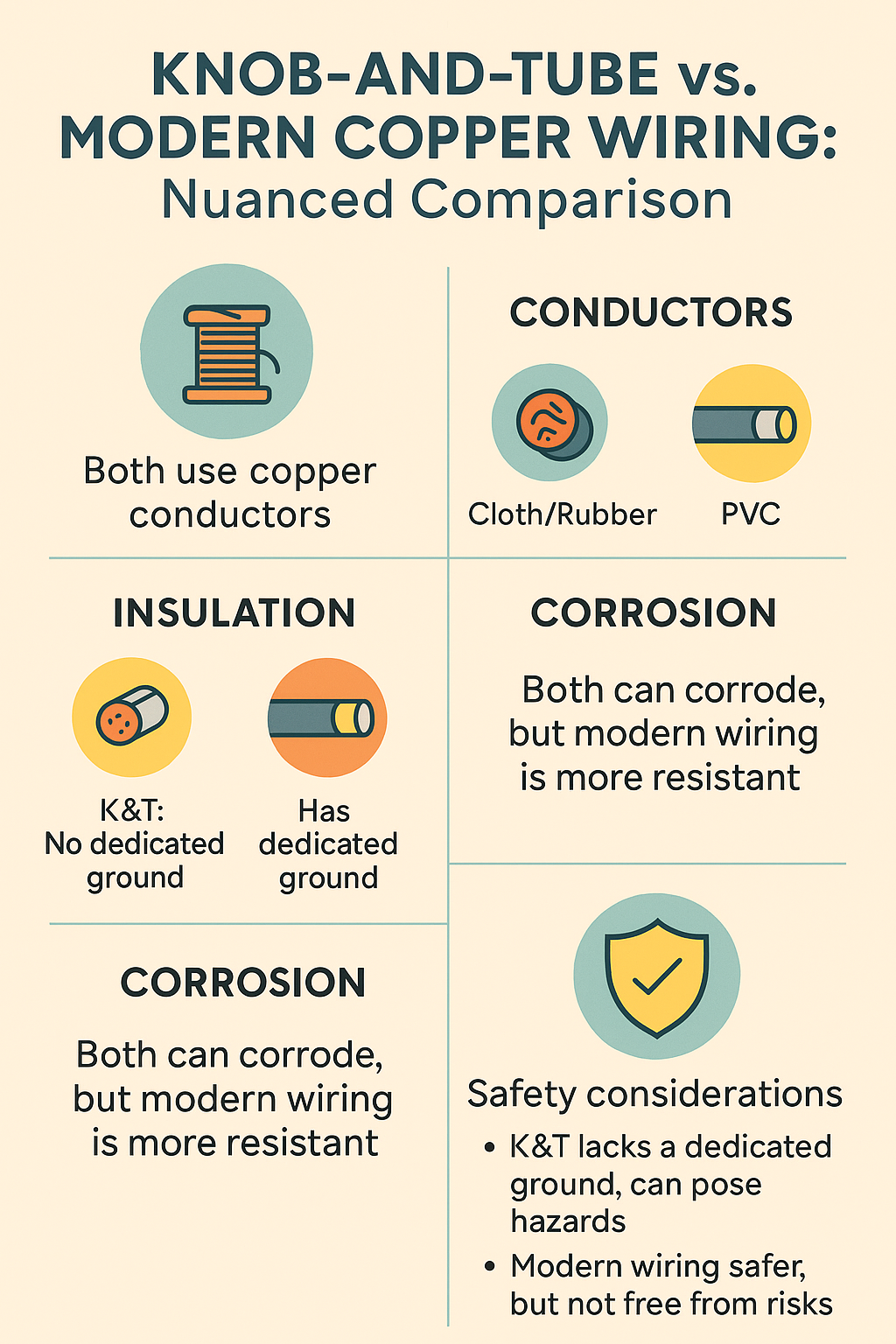
8. Electrical Shocks or Tingling
Even a slight “tingle” or small shock when touching an appliance, switch, or metal box signals a serious wiring fault—often faulty grounding, damaged insulation, or a loose neutral. These currents may be small, but they indicate that electricity is taking an unintended path through you, which can lead to more severe shocks, equipment damage, or hidden arcing that degrades wiring over time.
A qualified electrician will first perform a thorough ground-fault test using specialized meters to verify that your grounding and bonding meet code. They’ll inspect outlets, switches, and light fixtures for broken insulation or loose connections, then repair or replace damaged wiring and install GFCI or AFCI protection where needed. Addressing these “tingles” promptly not only prevents hazardous shocks but also restores the integrity of your electrical system.
9. Unexplained High Energy Bills
When your monthly power bill suddenly jumps—with no new appliances or behavioral changes—your first instinct might be to suspect faulty wiring. In reality, most “hidden” wiring faults (shorts, ground faults, loose connections) won’t quietly sip extra kilowatt-hours; they trip breakers or generate heat, not continuous load. Before blaming your wiring, compare your usage data month-to-month—look for seasonal HVAC spikes, pool pump runtimes, electric vehicle charging, or rate-plan changes.
That said, an electrical audit can still save you money. A licensed electrician will review your smart-meter history to flag abnormal draw, use a clamp-meter to measure real‐time circuit loads, and perform a thermal scan to spot resistive losses at poor connections. They’ll also inspect motors, pumps, and timers for inefficient operation, tighten or replace corroded terminals, and balance heavy loads across dedicated circuits. By combining load analysis with usage pattern insights, you’ll uncover true culprits—whether it’s an overworked HVAC compressor or a loose neutral wasting energy as heat—and optimize your home’s electrical efficiency.
See:
What Causes unexpected high Energy Bills
See:
High Electric Bill? Maybe this could be your problem!
See:
Reasons for you High Electric Bill
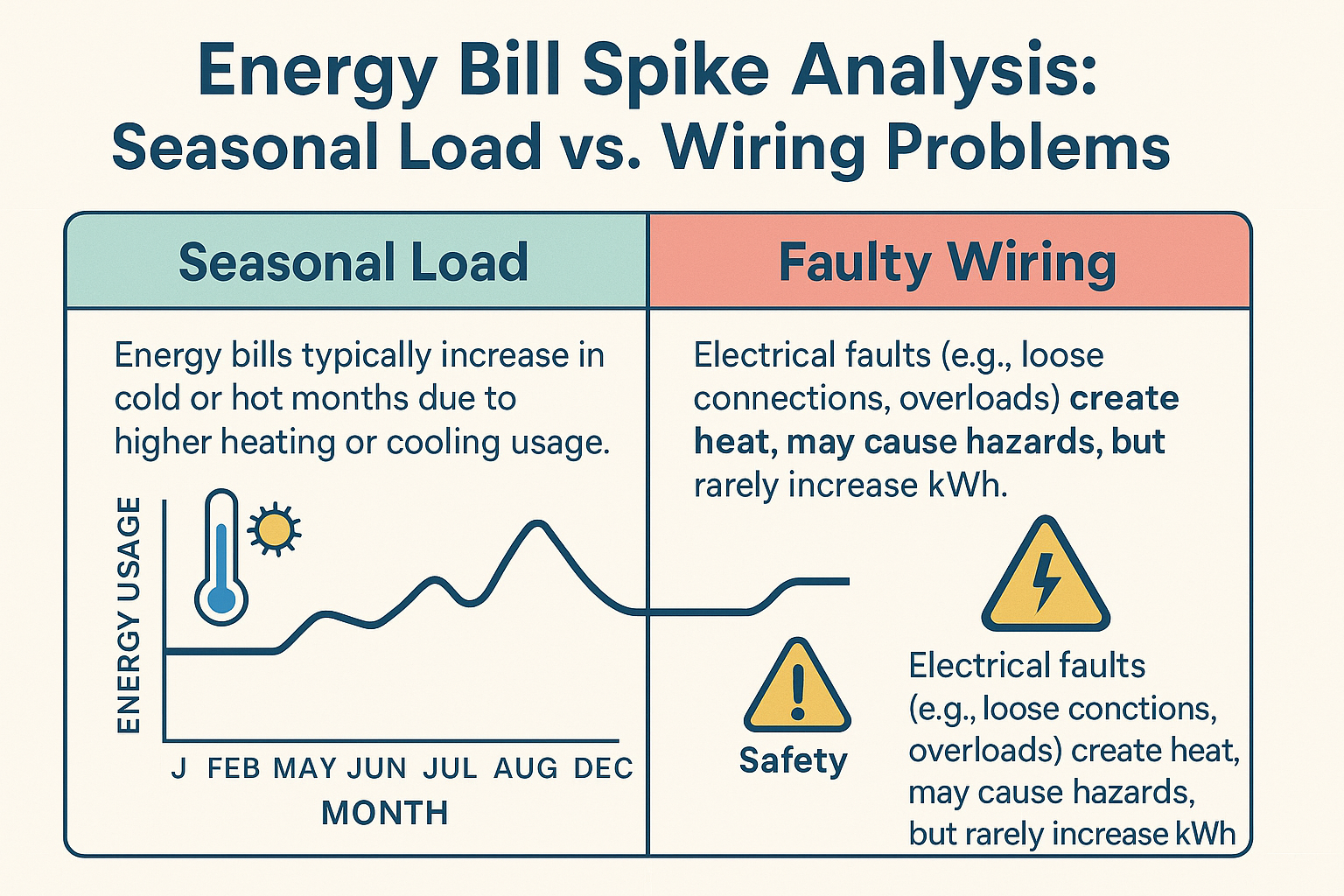
10. Aging or Faulty Electrical Panel
Most breaker panels are designed to last 25–40 years, but age—even without obvious damage—can compromise their ability to protect your home. Legacy panels from brands like Federal Pacific or Zinsco are notorious for failing to trip under overload or short‐circuit conditions, leaving wiring vulnerable to overheating and fire. Signs of a failing panel include breakers that won’t reset, scorch marks around the panel enclosure, or a hot-to-the-touch cover.
Upgrading to a modern, higher-capacity panel not only restores reliable overload protection but also gives you room for today’s electrical needs—EV chargers, home offices, smart appliances, and HVAC systems. A licensed electrician will assess your service amperage, replace the old panel with a new unit (often 200 A or higher), install arc-fault (AFCI) and ground-fault (GFCI) breakers where required, and label each circuit clearly. This investment ensures your electrical distribution meets current codes, enhances safety, and future-proofs your home against ever-increasing power demands.
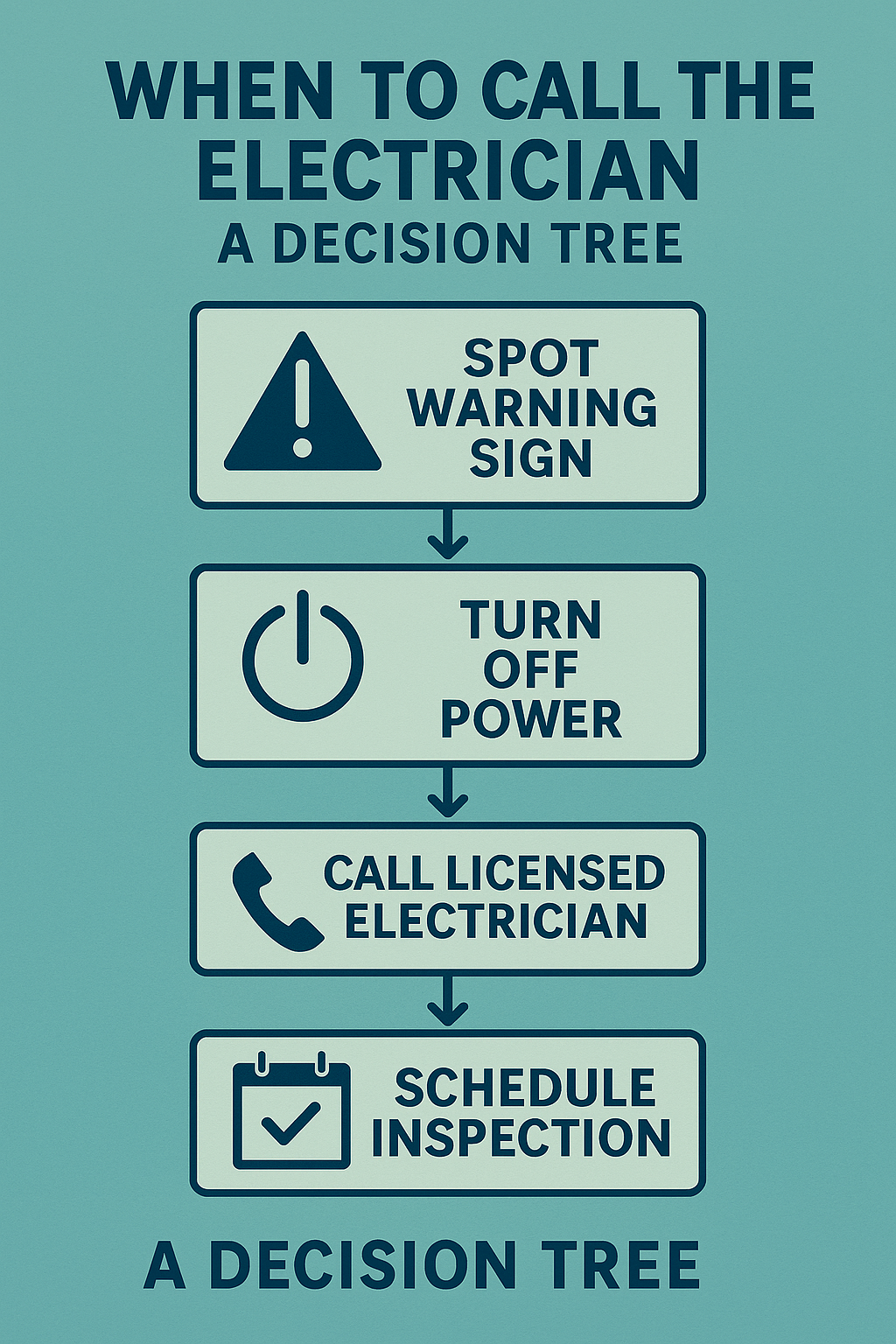
Conclusion
Electrical problems rarely improve on their own—and what starts as a minor annoyance can quickly escalate into a serious hazard. By keeping an eye out for the 10 warning signs covered in this guide—such as dimming lights, buzzing outlets, or scorch marks—you’ll be equipped to take swift action before small issues turn into emergencies. Proactive electrical maintenance not only safeguards your home against fires and shocks but also optimizes performance and energy efficiency, potentially lowering utility costs over time.
At C.A.S.E. Contracting, we’ve provided exceptional residential and commercial electrical services across Grass Valley, Nevada City, North Auburn, Penn Valley, Truckee, and Downieville since 1984. Whether you need panel upgrades, generator installations, lighting design, EV charger setup, or troubleshooting, our licensed and insured electricians treat every client like family—and every home like our own. We work with top brands such as Eaton and Siemens and handle everything from remodel wiring to heated roof cable installation.
Ready to protect your home?
Call us at (530) 277-0917 You can email us at casecontractinginc@gmail.com or click “Contact Us” on our website to schedule your professional electrical inspection.
Don’t wait for an outage or accident—address electrical concerns early to enjoy reliable power, peace of mind, and a safer living environment.
FAQs
Q1: How often should I have my home’s electrical system inspected?
A: Every 3–5 years for older homes, or whenever you notice warning signs. Upgrades after major renovations or appliance additions are also wise.
Q2: Can I ignore flickering lights if they only happen occasionally?
A: No. Even infrequent flickers stress bulbs and electronics. They often precede more serious wiring faults.
Q3: What’s the cost of rewiring a home with outdated wiring?
A: Costs vary by home size and complexity, but full rewires typically range from $4,000 to $12,000. Think of it as a long-term safety investment.
Q4: Are GFCI outlets sufficient protection in wet areas?
A: Yes. Ground-Fault Circuit Interrupter (GFCI) outlets detect ground faults and shut off power in milliseconds—essential for bathrooms, kitchens, and outdoor outlets.
Q5: How do I find a qualified electrician?
A: Look for licensed, insured professionals with good reviews. Verify credentials with your state’s electrical licensing board and ask for references.



